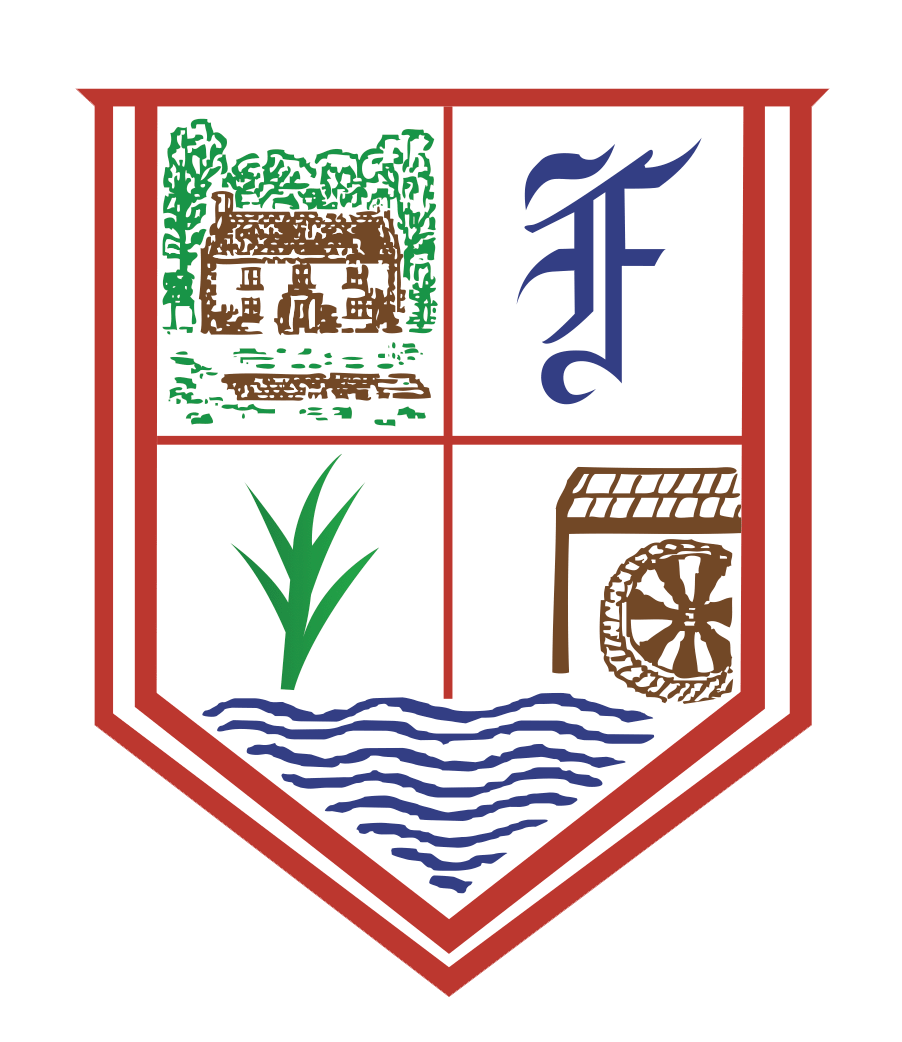| Panel 1 Ancient History | Panel 12 The Paper Mill |
| Panel 2 The Sixmile River | Panel 13 The Narrow Gauge Railway |
| Panel 3 Schools in Ballyclare | Panel 14 Ballyclare Bleach Green |
| Panel 4 The Great Balloon Escape and The Cinema | Panel 15 Ulster Scots |
| Panel 5 Ballyclare Mayfair | Panel 16 Archibald McIlroy |
| Panel 6 Fairview Primary School | Panel 17 The Foundry |
| Panel 7 Ballyclare High School | Panel 18 Baird’s Pleasure Garden, Ollar Lodge and Main Street |
| Panel 8 Ballyclare Primary and Secondary Schools | Panel 19 Ballyclare Victoria and East Antrim Harriers |
| Panel 9 The Market House and Town Hall | Panel 20 Ballyclare Comrades FC |
| Panel 10 Town Square and Cunningham Memorial | Panel 21 Local Churches |
| Panel 11 The Broad Gauge Railway | Panel 22 Ballyclare Rugby Club |
Panel 1: Ancient History
In War Memorial Park, you will find a Motte, 3.7 metres high and 126 square metres in area. This motte is about 700 years old and was constructed by the Normans. The Motte is approximately six Irish miles from the castle at Carrickfergus as the soldiers marched towards Antrim, giving the river which flows through Ballyclare a new name!
If you stand on top of the Motte and look out towards the river, you can see Riverdale in the distance. When these houses were being built, a horde of 22 flint arrowheads were found, which are now held in the Ulster Museum.
Did you know?
Many souterrains, artificial underground caves, can be found around Ballyclare, dating back to well over 1,000 years. The raids by enemy tribes and Vikings made it necessary to have hiding places for people and possessions.
By Lucy Semple
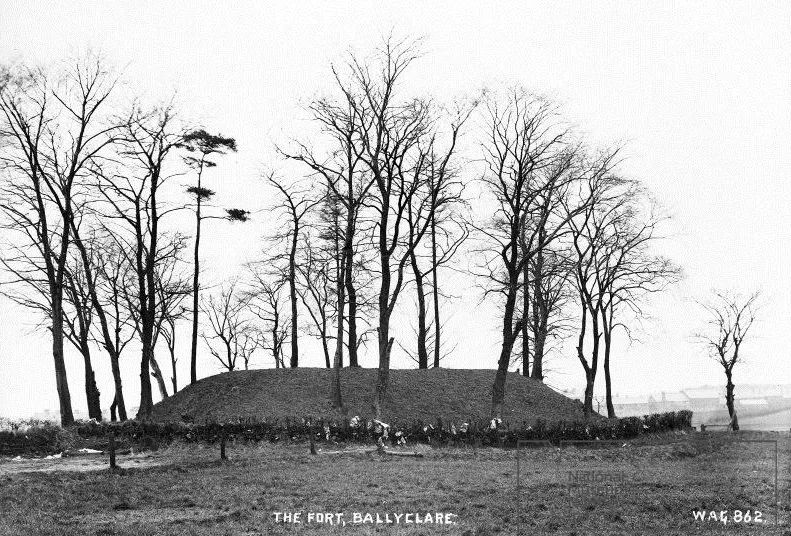
Panel 2: The Sixmile River
The Six Mile River is actually almost 26 miles long! The former name was the River Ollarbha, an old Irish word meaning ‘rushes’. The river as we know it starts in Ballyboley and flows through Ballyclare before heading towards Templepatrick and eventually joining Lough Neagh in Antrim.
It is believed that it gets its name from soldiers who were marching from Carrickfergus Castle to Antrim and calculated that they had marched six miles by the time they reached Ballyclare.
Did you know?
Some old maps use ‘Irish miles’ instead of the ‘miles’ we know today. The Irish mile was 1440 feet or about 439 metres longer than a British mile.
By Tom Livingston

Panel 3: Schools in Ballyclare
The ‘Wudden Box’
Founded in 1810 on the Doagh Road, this school was a wooden building which had previously been used for services by the Presbyterian congregation while their new church was being built. It had a thatched roof and three windows, fit to accommodate 60 children. Thomas Kelly was the first known teacher in the school, retiring in 1855. Thomas Percy succeeded him.
The ‘Wudden Box’ was eventually transported from its site on the Doagh Road to nearby Foundry Lane (Tow Loanin’). In 1860 the appointment of the first female assistant was made, although the school remained as one single room, with an enrolment in 1877 of 170 children!
Did you know?
In 1832, Mr Kelly was being paid £20 per annum, with the children contributing 2 pence per week to this cost.
By Daisy Adair
‘Fractions’ School and Mr McCune
The other school in Ballyclare was a two-storey stone and slate schoolhouse which had been built in 1800 and cost £40. The school was located on the east side of Fair Green, or the Square as we know it now. It could accommodate 60 children in total on the ground floor, with a female school on the upper floor added in 1850.
David John McCune, who was known as ‘Fractions’ because of his ability to complete puzzling calculations, taught in the school from 1845. A fine exponent of the Ulster Scots tongue, he was an exceptional teacher and achieved the Board’s highest classification. Ill health and tragedy in his family led to numbers falling in his school and it closed in 1880.
Did you know?
The upper room in this school was used as a lending library before becoming the female school, and then continued as a library in the evenings.
By Lily Andrews

Panel 4: The Great Balloon Escape and The Cinema
Have you ever heard the story about the flying car? It actually happened in Ballyclare. In November 1941, Jack Grange was driving along the Ballynure Road, coming home from Larne. World War II was raging and Belfast had just been bombed by the Germans. One precaution introduced was the installation of barrage balloons around Belfast…but one became detached and headed for Ballyclare!
Mr Grange, who was the owner of the Northern Bar (now known as The Grange Bar), saw the balloon and cable heading for his car. He swiftly exited as the cable caught the front of his car and lifted it into a nearby tree. Mr Grange made the most of his close encounter and happily told the story to all who came into his bar! He even coined the phrase ‘Above all others…’ to promote his bar.
Did you know?
Ballyclare once had two cinemas! The Reo Cinema on Main Street, close to Avondale Drive, was opened in the late 1920s and had 350 seats. It was still operating up until 1953. The second, newer cinema was called the New Reo. It was located on the Ballynure Road, opposite the entrance to War Memorial Park.
By Hollie Patton
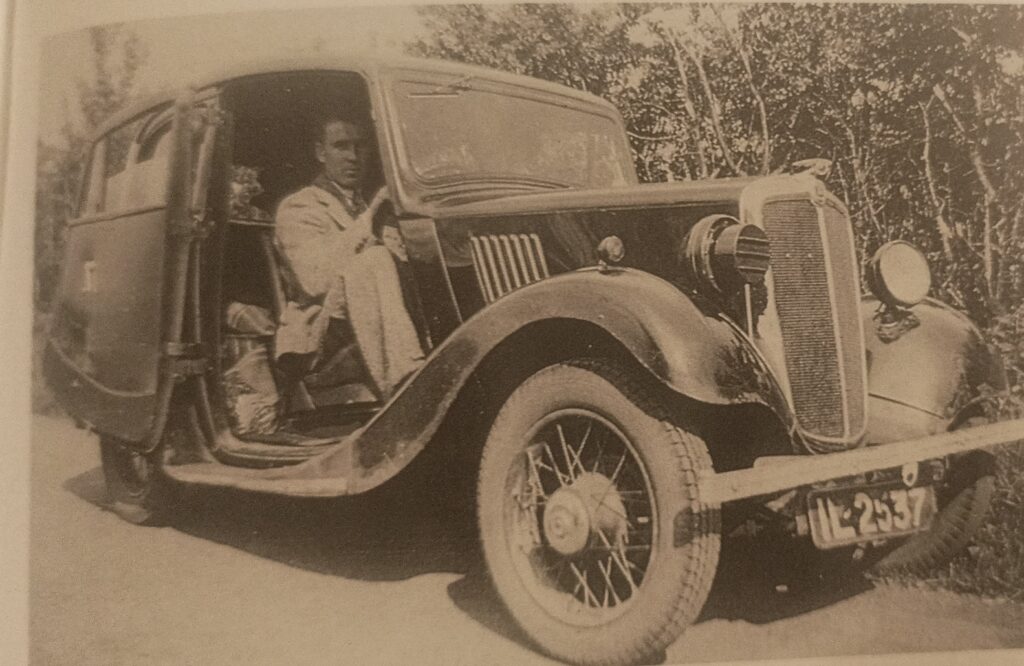
Panel 5: Ballyclare Mayfair
On the 16th December 1756, George II granted to the Earl of Donegal the right to hold two fairs annually. The first May Fair started in 1756 and was originally a market for animals and goats. By the late 1800s, horse trading became the main purpose of the Fair. May Fair Day was traditionally on a Tuesday however, nowadays the May Fair celebrations last for a week!
The first amusements joined the May Fair in 1949, including the still very popular dodgems. By the late 1950s, the local papers were reporting that the May Fair was attracting 20,000 people to the town. Throughout the years many events have been added to the week including football tournaments and boxing competitions, and some of the most popular in recent years have been It’s a Knockout and the Soap Box Derby.
Did you know?
The May Fair was not just for purchasing animals, it was often where local landowners hired their labouring men and servant girls for the next six months!
By Jacob Spiers and Isla McKee
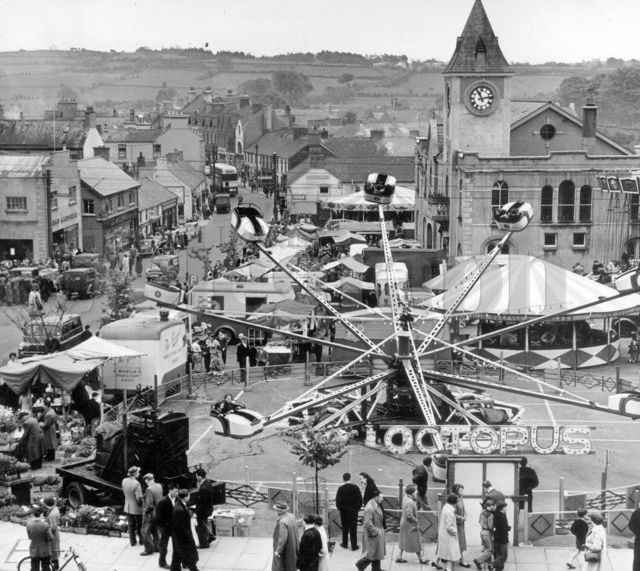
Panel 6: Fairview Primary School
On Monday 1st September 1980, Fairview opened its doors for the first time. The first Headmaster was Mr Jack McKinney. Mrs Carol Maxwell succeeded Mr McKinney as Principal in 1986, followed by Mrs Paula Matthews who was appointed Principal in 2011. Former pupil, teacher and Vice Principal Mr McAllister was appointed Principal in 2023.
Fairview Primary School has grown rapidly since it opened in 1980. Beginning with only 5 classes and under 100 pupils, the school now has over 500 pupils with 3 classes in each year group. The school crest, created by Mr McKinney, is a tribute to Ballyclare’s history, incorporating the mill wheel from the original paper mill at Millvale, the Ollar River and linen flax.
Did you know?
Fairview Primary School gets its name from a former residence that used to occupy the site on which the school is built. You can see an image of the house, which is no longer standing, on the school crest.
By Alice Montgomery

Panel 7: Ballyclare High School
In September 1902, Miss Aikin took over The Misses Douglas’ School for Young Ladies in the Torrens Memorial Hall in Doagh. In 1904, she moved her school to new premises on the north side of The Square in Ballyclare.
In 1916 Miss Aikin’s school amalgamated with another school in the town, with Miss Aikin becoming principal. It was named Ballyclare Intermediate School and it moved to its first premises on the Rashee Road, in five rooms above what is now McCandless Opticians.
In 1925 the school was placed under the control of the Ministry of Education. Miss Aikin was paid £96 for the school and the premises and furnishings were placed into a trust to be managed by a new Board of Governors. She resigned as Headmistress but continued as the new Principal Mr Fowweather’s assistant until she retired completely from teaching in 1927.
The school moved to its current home on the Rashee Road in 1930 and changed its name officially to Ballyclare High School in 1935. It would be another 88 years before the school would have its next female Principal!
Did you know?
When he took up post in 1925, Arthur Fowweather was believed to be the youngest Headmaster in the British Isles.
By Holly McMurray
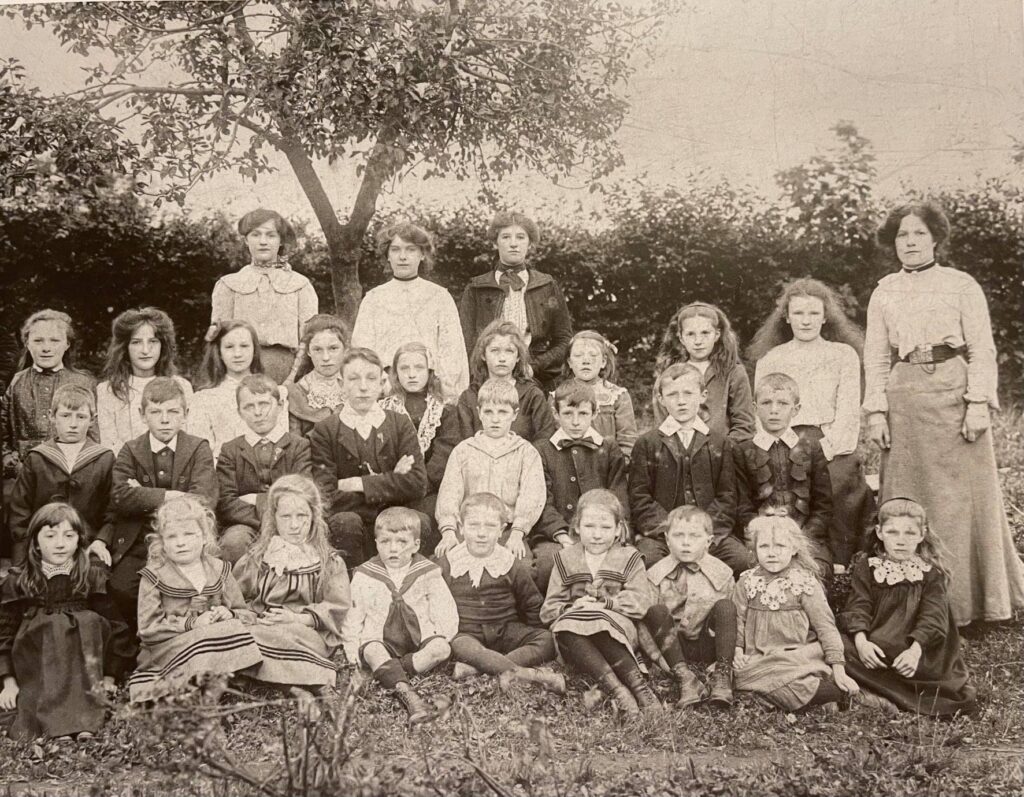
Panel 8: Ballyclare Primary and Ballyclare Secondary Schools
Ballyclare Primary – Boys’ and Girls’ National School
With the demise of ‘Fractions’ academy, and the excessive numbers enrolled at Percy’s ‘Wudden Box’ in the late 1870s, there was a need for a new school in Ballyclare. On 25th July 1881 the new male and female school officially opened in its new building, just off School Street in Ballyclare. This was a grand occasion, with a brass band parading to Thomas Percy’s school on Foundry Lane to collect the children, back to The Square to gather those remaining pupils of ‘Fractions’ Academy, down to the ‘fit-o’-th’ toon’ and back again to The Square, finally reaching their new seat of learning.
Boys were taught downstairs and girls upstairs, each in a large room. The first Principal of the Boys’ School was Mr Thomas Percy, who moved with his pupils from Ballyclare No. 1 school. Miss Margaret Valentine (subsequently Mrs Stalker) took charge of the Girls’ School.
Did you know?
The plaque that says ‘Ballyclare Male and Female National Schools’ can still be seen on the side of the school building, although this is not where it was first placed. The date indicates when the building was constructed, but the school actually opened a year later in 1881.
Ballyclare Secondary School
Ballyclare Secondary School opened in 1961, with Mr Bill Sterling taking on the role of Principal. He was succeeded by Mr Uel McCrea in 1985. Both men served the school with distinction for over 20 years, and Ballyclare Secondary gained a well deserved reputation as one of the top secondary schools in Northern Ireland.
By Bobby Wilson

Panel 9: The Market House and Town Hall
The first wooden market house in Ballyclare was erected in the eighteenth century for the handloom weavers selling in the linen market which ran in the town up until 1851. It wasn’t until 1866 that a more substantial stone construction was erected at a cost of £480, with a meetings space at the top and the market on the ground floor with equipment and storage areas for use on market and fair days. An upper storey was added in 1873 which was to be used as a Town Hall, separate from the Market House beneath. In the early 1930s ambitious plans were made for the extension of facilities in the Town Hall and on Wednesday 23 October 1935, the new building, with its magnificent dance floor and impressive new clock and clock tower, was officially opened by Lord Lieutenant of Belfast, Sir Thomas Dixon.
The peak of the clock tower spire is about 60 feet from the ground. The clock face is 5 feet 2 inches in diameter, but the tower which houses it only has three faces!
The Town Hall is used for events, weddings, dances, concerts and theatrical performances.
Did you know?
The dance floor in the Town Hall is specially constructed of Appalachian seasoned oak and is set on springs which can be adjusted to make it either rigid or flexible.
By Lucy McClelland

Panel 10: The Town Square and Cunningham Memorial
At the end of the Great War, King George V sent two artillery guns to Ballyclare in recognition of the many men from the town and district who gave their lives for their country during the conflict. The guns were said to have been captured at the Battle of Messines in June 1917, during which the men of Ballyclare, mainly in C Company of the 12th Battalion of the Royal Irish Rifles, were to storm and take the fortress village of Messines in half a day’s fighting.
The guns sat at the top of the Square until around October/November 1940 when they were removed to be melted down and used in the war effort. Take a look at the only surviving image of the guns at the Square and the aerial photo, to show where they were located.
Another feature of the town Square until 1951, was a tall monument called the Cunningham Memorial. It was built in 1854 in memory of the doctor who practised in his native town for over fifty years until 1853 when he died aged 71. The monument was knocked down in 1951.
Did you know?
If the monument hadn’t been knocked down it would have been within the railings that are in place around the Town Hall today.
By Rose Livingston
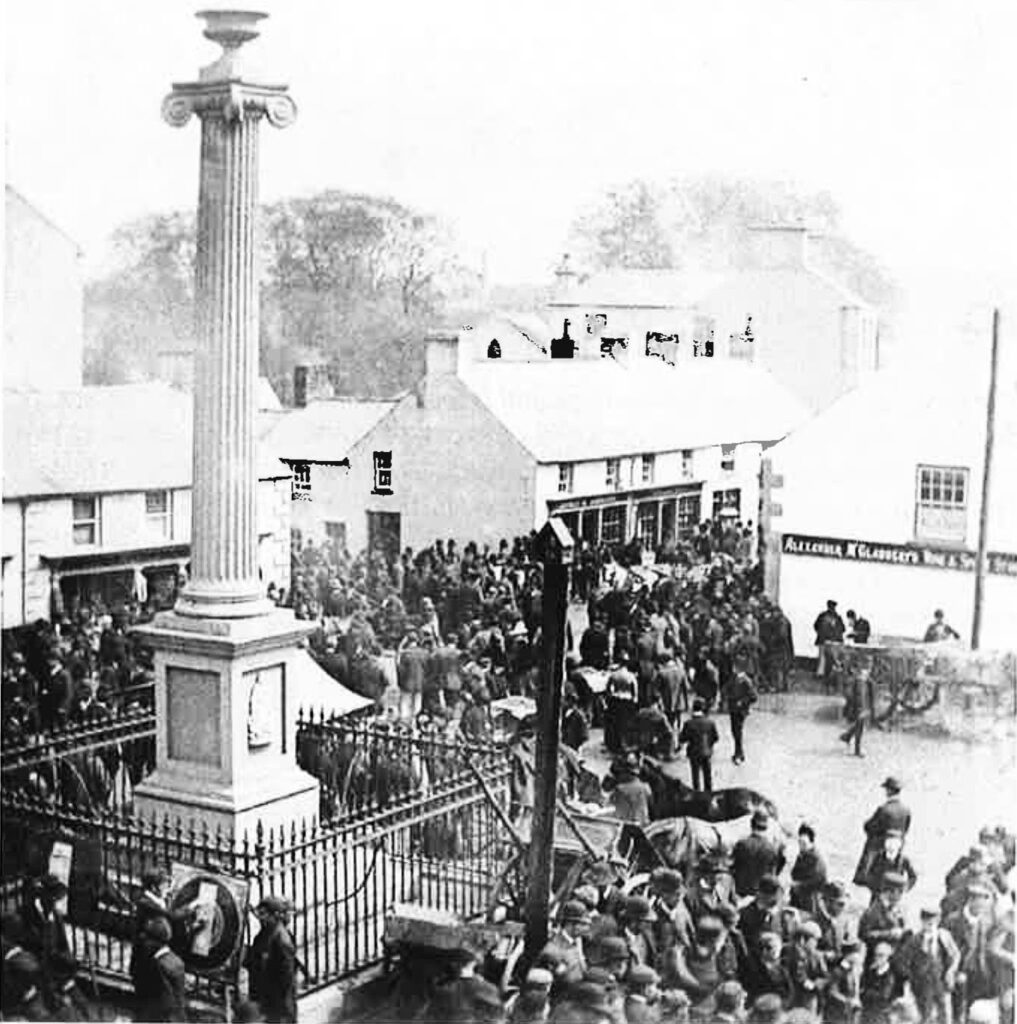
Panel 11: The Broad Gauge Railway
By the late 1800s, visitors to Ballyclare could arrive on the London, Midland & Scottish Railways service from Belfast. The Broad Gauge line was opened by the LMS Belfast to Ballymena Railway Company in 1888. It was taken over by the Belfast and Northern Countries Railway in July 1889. There were extensive goods yards, as well as passenger facilities, at the junction of the Hillhead Road and Mill Road. The railway officially closed to passengers in the 1930s, but children departed for outings on special excursion trains for many years to follow, such as the Sunday School outing to Portrush. A definitive date is unclear but it is likely the railway fully closed in the late 1940s or early 1950s.
Did you know?
The door of the railway station where the trains arrived into is still there today. Have a look at Modern Tyres next time you are driving through Ballyclare and see if you can spot the big red door!
Heidi Hassard and Alice Montgomery

Panel 12: The Paper Mill
For two centuries, Ballyclare was the home of paper making in Ireland. Ballyclare came to be known as ‘Paper Town’ due to its renowned paper mill. The original mill was on the Ballynure Road, at the point as the road turns and climbs steeply. This area was known as Millvale. The mill was powered by a water wheel which you can see on Fairview’s school crest.
In the mid 1800s, the mill moved to a new site at the far end of what we know as Sixmilewater River Park. The North of Ireland Paper Mill Company opened in 1871, with a narrow gauge railway set up between Larne and Ballyclare to service the thriving business. At its peak, the mill employed up to 500 workers, so it was a terrible blow for the town when it closed in 1950.
Did you know?
The landmark 157ft high paper mill chimney was demolished in June 1989 by TV celebrity Fred Dibnah and many local people kept one of the bricks as a souvenir.
By Connor Simpson
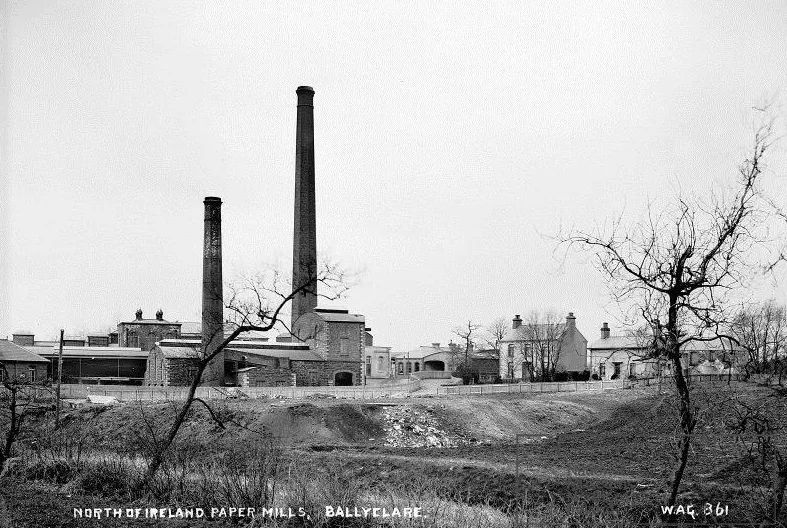
Panel 13: The Narrow Gauge Railway
The bridge on Main Street currently takes you over the Sixmile River, but back 100 years ago, something else passed under the bridge. The Paper Mill had a constant supply of clean water but it was three miles from the nearest railway line.
The Larne and Ballyclare Railway Company was formed, creating a 3 foot Narrow Gauge railway line which opened in 1877. It brought pulp from Larne Harbour directly to the Paper Mill, and also transported finished paper for distribution around Ireland and beyond. Passenger services ended in 1933 and the last part of the railway closed in 1950. From east to west, the railway ran for 32 miles between Larne and Ballymena.
Did you know?
The Narrow Gauge did not only serve the Paper Mill. Trains also puffed under the bridge on Main Street to a station where coal was unloaded to be transported to ‘The Green’ by horse and cart.
By Heidi Hassard and Alice Montgomery
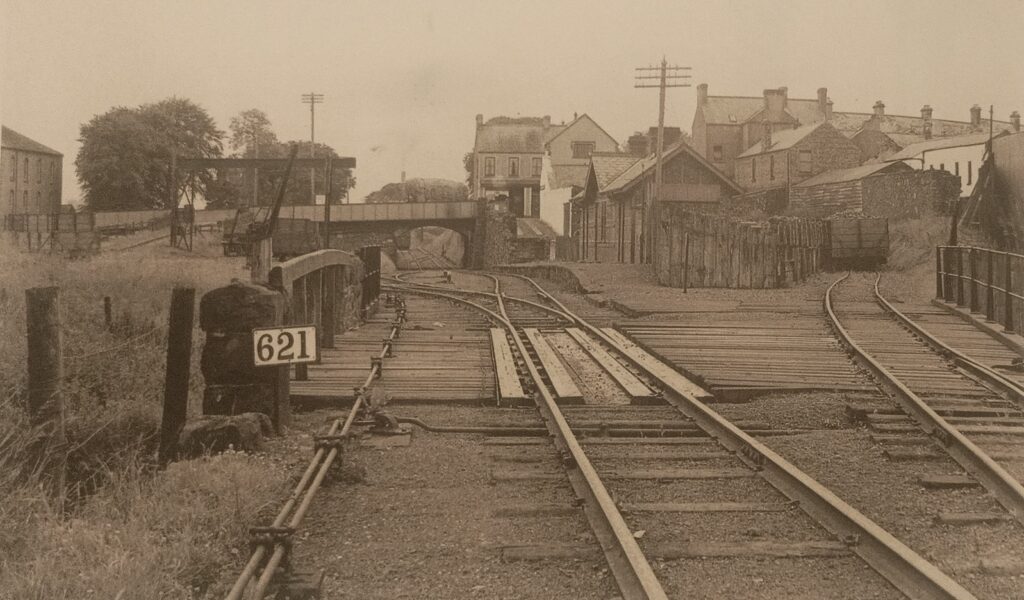
Panel 14: Ballyclare Bleach Green
The bleach works on the Green Road operated in the middle of the eighteenth century under the name of William and John Bell and Company. It was eventually bought in 1873 by John J Kirkpatrick. You can still see the name displayed on the main building. Ownership subsequently changed hands, including a merger with Lancashire Combine in 1900, leading to huge development and modernisation of the site, but the name stayed.
Villagers had always bleached their linen by spreading it on the grass, known as ‘grass bleaching’. At Kirkpatrick’s, as late as the 1930s, linen was being spread out on the green, covering as many as six or seven acres, where nature transformed the raw green yarns into the perfect snow white shade forever associated with Ireland’s famous fabric.
Until 1910, all the transport to and from Belfast was by horse and cart. Cross channel goods were dispatched by the Broad Gauge Railway to Belfast Harbour and by Narrow Gauge to Larne. The firm was at its trading peak during the closing months of the First World War. At one time, over five hundred workers were employed there.
Did you Know?
One of the most famous employees of Kirkpatrick Bros. Bleachworks was Robert T Grange, commonly accepted as the original historian of Ballyclare and thanks to whom we know so much about our town’s past.
By Rosie McAllister with Cllr. Vera McWilliam

Panel 15: Ulster Scots
Ballyclare has a rich history of Ulster Scots. One of the town’s most famous sons, Archibald McIlroy, wrote many of his books in Ulster Scots. Take a look at the phrases below – can you work out what is being said?
A parent commenting on what he expected to happen in school for his son:
‘Keep him at readin’ writin’ an’ coontin’, dinna waste his time on jography; for efter a, whor’s the use o’ his learnin’ the names o’ a when o’ places ‘at he’s niver likely tae see.’
Mr McCune as he introduced a geography lesson:
‘Boys, noo a hae bee a ‘roon the world, and a when o’ ither places forbye.’
One man’s comment as he departed the old paper mill at Millvale following the dreadful accident at a mesmerism lecture, when the floor collapsed killing three men and injuring many more. Can you spot anything odd about what he is saying?
‘The floor’s collapsed and there’s hundreds deed. Beath ma legs is broke an’ am runnin’ for the doctor.’
By Jess Dickey
Panel 16: Archibald McIlroy
McIlroy was born in 1859. He did a lot of writing in the Ulster Scots language, his two most famous books being The Auld Meetin’-hoose Green and When Lint was in the Bell.
A lot of what we know about Ballyclare’s original two schools comes from Archibald McIlroy as he attended both schools. In fact, the nickname ‘Fractions’ given to Mr McCune was first recorded by McIlroy. Tragically, McIlroy died on the Lusitania when it was torpedoed by a German submarine in May 1915. He has a Blue Plaque dedicated to him on the wall of the Town Hall and is also remembered by a plaque inside Ballyclare Presbyterian Church.
Did you know?
Archibald McIlroy was a fine exponent of Ulster Scots, quoting Mr McCune in one of his lessons as saying, ‘Haul up yer hands like men an’ dinna be fear’d tae let oot yer voices’. How might a teacher say this now?
By Jude Forsythe

Panel 17: The Foundry
The evidence suggests that John Kane & Sons set up a branch of their Foundry in Ballyclare around 1901, known as Ballyclare Foundry (Iron and Brass). Ownership passed from the Kane family to Samuel Millar some time prior to 1906 and eventually to the Beggs family who ran the foundry until its closure. The foundry was demolished in 1983 and the site cleared for the Ollar Fold to be built soon after.
The establishment and success of the foundry was certainly related to the expansion of steam powered industries in the Six Mile Water valley from the middle to the end of the 1800s, including trade with The Paper Mill and ‘The Green’ (Kirkpatrick Bros.). Plans have been found to suggest the original iron gates for War Memorial Park were made at Ballyclare Foundry, although we know these were removed during the Second World War and melted down for the war effort.
Did you know?
The route up to the site from the Doagh Road was called Tow Loanin’ before it became Foundry Lane. The ‘Wudden Box’ school was open close by from 1859 to 1881.
By Oscar Irvine

Panel 18: Baird’s Pleasure Garden, Ollar Lodge and Main Street
Ollar Lodge is situated towards the lower end of Main Street. This area of Ballyclare was known as ‘Le Ballyclare’, or the ‘Foot of the Town’.
Throughout the 1800s, Ollar Lodge was separated from Main Street by a row of iron railings. In addition to the beautiful big weeping ash which once stood in the centre of the garden, there were two fine overhanging trees, one growing at each corner of the grounds. Here, on hot summer days, the ‘Ancients’ of the village would gather to enjoy their afternoon gossip!
Situated across the Main Street from Ollar Lodge and including a collection of antiques was the Baird’s Pleasure Garden. This hidden gem dated back to the Victorian era and included attractions such as caves and fountains which squirted water on the passing tourists, and a table which collapsed when they sat down. When building work was going on, an old well was uncovered which no doubt supplied the water for the effects.
Did you know?
One of the Victorian lantern slides shows the famous bronze lion which, thanks to an employee hidden behind it, roared to startle visitors.
By Quin Reeve
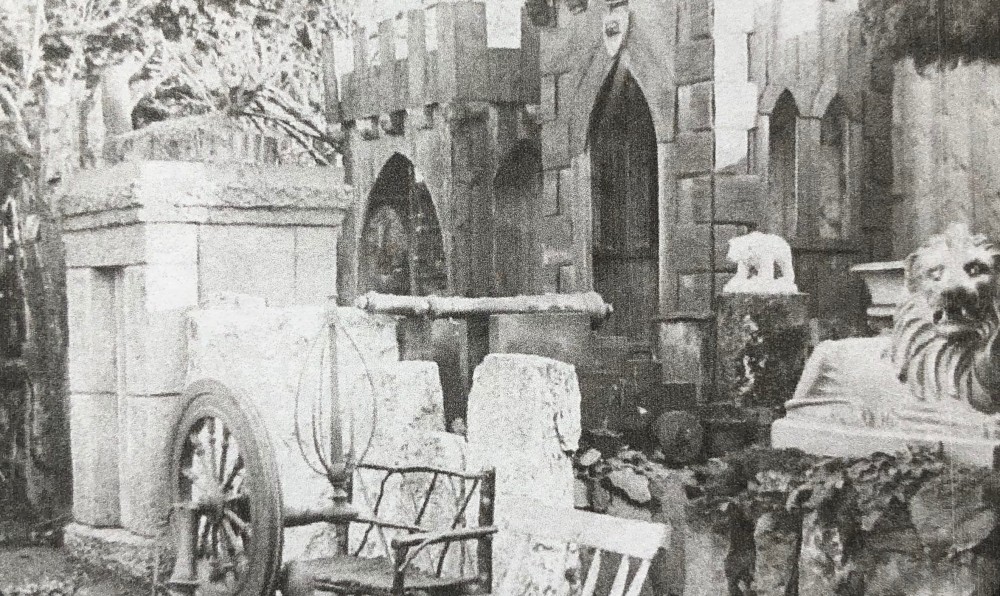
Panel 19: Ballyclare Victoria and East Antrim Harriers
Ballyclare Victoria Flute Band
Ballyclare Victoria Flute Band was formed in early Spring 1919, around the same time the Ballyclare branch of the Comrades was being formed. When they started, no one in the band could play a flute but they set themselves a target to be ready to perform by the Summer of that year.
The brainchild of Robert McFarlane and James Simms, the first public appearance of ‘McFarlane’s Band’ was on 9th May 1919. In 1931 the band joined the Northern Ireland Bands Association and appointed Robert Meharg as conductor. They won their first World Championship in 1960 and have won another 22 World Championships since.
Did you know?
The Ballyclare Victoria Flute Band, led by Arthur Fleming, won 10 World Championships in a row from 1975-1984. This record is unlikely ever to be beaten!
By Noah Creighton
East Antrim Harriers
In September 1907, a small group of Ballyclare-based runners decided to form their own club in the town. They met in a barn at the back of Baird’s public house on Main Street and chose the name East Antrim Harriers. It wasn’t long before the club made its spectacular entrance on the athletics stage, when Bob Kerr won the Ulster Senior Cross Country Championships in 1909.
In 1925, the Harriers came first in the Northern Ireland Junior Cross Country Championships and a repeat performance the following year started a sequence of successes that is unlikely to be surpassed by any other club. From 1926 to 1958 they won the Northern Ireland Cross Country Championships a remarkable 24 times, including 13 successive victories.
Did you Know?
The club now trains from its own clubhouse on Harrier Way, the road being named in honour and recognition of the part played by East Antrim Harriers in the development of sport in Ballyclare, Newtownabbey and throughout Northern Ireland.
By Amelia Fleming

Panel 20: Ballyclare Comrades FC
In February 1919, two men who had fought in the First World War sat talking in the Comrades of The Great War Association Ballyclare headquarters. They suggested they should have a football team in the town.
A week later, Ballyclare’s soldiers, made up of men who had fought at the Somme and many other battles during The Great War, played their first game of football at a ground on the Ballynure Road, just behind the site of the old Police Station. They won their first game and the Club would go on to win its first Steel & Sons trophy in 1943, followed by another 5 successes in that competition, 6 Irish League B Division titles, 8 IFA Intermediate Cups, 4 George Wilson Cups, 2 Irish League B Division Knockout Cups and an Ulster Cup.
Did you know?
No other football team on the record in the UK goes by the name ‘Comrades’, making our own town team unique. The current ground where home matches are played was not the original home, but it has been home for most of the club’s history and gets its name from Major Daniel Dixon, who had been in France with many of the founding members of the club.
By Charlie Cross
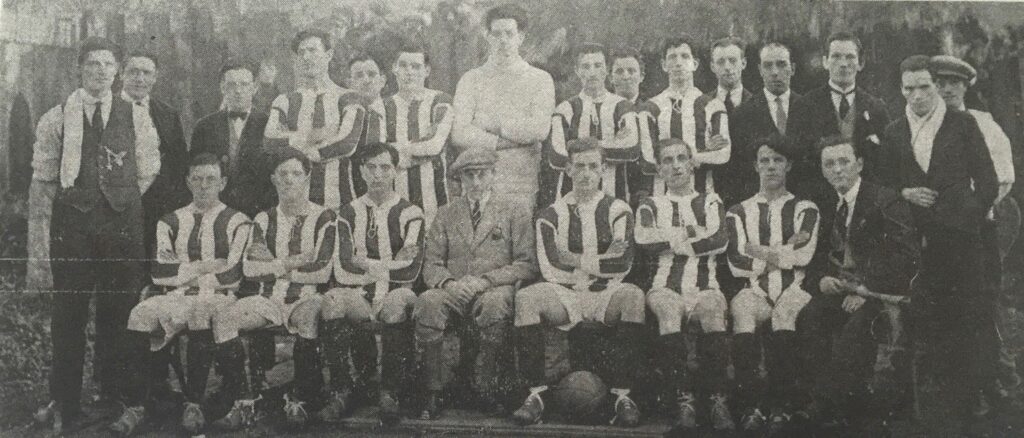
Panel 21: Local Churches
The oldest church in Ballyclare is the Old Presbyterian, built in 1642 on the Main Street. Ballyclare Presbyterian was built in 1859, the same year as the Great Revival in Ireland. This brought many people into the town of Ballyclare and during one service that year over 2,000 people attended. Old maps and pictures of Ballyclare show the Methodist Church and the Church of Ireland on their present sites.
In 1832, the local bishop obtained a plot of land where a small church was erected, which for 80 years served the needs of the Roman Catholic parishioners of Ballyclare. By 1900 population changes meant that a new church was required and land was obtained from Mrs Annie Hill of Ollarview to build this new church and parochial residence. The new building was officially opened on Sunday 11th June 1911 and it was named the ‘Sacred Heart Church’.
Did you Know?
During World War II, 1st Ballyclare Boys’ Brigade was set up in Ballyclare Presbyterian Church, largely at the request of evacuee boys from Belfast.
By Rebecca McDowell and Holly McCudden

Panel 22: Ballyclare Rugby Club
Ballyclare Rugby Football Club was formed on 20th May 1949 at a meeting held in Ballyclare High School, chaired by the then principal Mr Russell, some teaching staff and a number of past pupils. The name ‘Ballyclare Rugby Club’ did not come into being until 1950. The original name for the team was ‘The Ballyclarians’.
In the early days there was no clubhouse, so the meeting place became Carmichael’s pub in Ballyeaston and it was there that the emblem of the White Hare was created. While enjoying a drink after a tough training session, a small group of players noticed the stuffed white hare on display in the pub. The hare is known for its power and this represented the forwards. But the hare is also known for its speed and agility, representing the backs. What could be more perfect to become the emblem for Ballyclare Rugby Club? The hare can still be seen on all club insignia and is often sung about on a Saturday after another successful outing for one of the many representative teams, from mini rugby right up to the hugely successful 1XV.
As I was walking down the Rashee Road
I met a great white hare
And it said to me, we’re off to see
The famous Ballyclare!
Russell Park on the Doagh Road was the home to Ballyclare Rugby Club for many years. This land was sold in the late 1980s for development and is now Russell Manor, taking its name from one of the founding members of Ballyclare Rugby Club. As stated earlier, Mr Russell was the principal of Ballyclare High School when he was involved in setting up the new rugby team. Aikin Square on the Rashee Road is named after the original principal of Ballyclare High School, Miss Catherine Aikin!
After selling the land on the Doagh Road, the club moved up Cloughan Lane to its new home. The impressive clubhouse, built and financed by the Old Ballyclarians, came a little later, officially opened in 1992 by Arthur Fowweather M.B.E., the founder of The Old Ballyclarians Association. With a setting of 38 acres lying within County Antrim’s picturesque Six Mile Valley Ballyclare Rugby Club boasts one of the finest grounds in all of Ulster Rugby.
The four playing pitches at Ballyclare Rugby Club are named after significant past members, three of them founding members. The Russell Pitch, The Coulter Pitch and The Moore Pitch all acknowledge the role these men played in setting up the club. The Lindsay Pitch is named after Tommy Lindsay, not a founding member but a huge influence on the development of the club in the late 60s and 70s.
In the clubhouse first floor, you can view international shirts kindly donated by some of the club members such as British Lions Willie John McBride and Ronnie Lamont. You can also see the proud association Ballyclare Rugby Club has with The Old Ballyclarians, as well as team achievements over the years – notably holding the All Ireland Junior Cup, Ulster Junior Cup and Towns’ Cup all at once in 2024! Take a look at the Ballyclare Rugby Club website for a full list of honours.
Did you know?
Ballyclare boasts one of the largest mini rugby sections in Ireland, and former member Ronnie Lamont, who coached at the club during the 1980s, is credited with introducing mini rugby to Ireland after his 1966 Lions Tour to New Zealand.
Laurence Caldwell started mini rugby in Ballyclare in 1979, heavily influenced by his friend Ronnie Lamont. The mini rugby festival held in Ballyclare each year is regarded as one of the best in Ireland.
By Alfie Harris

